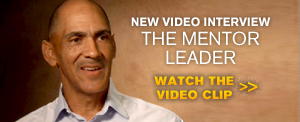Endorsement
Excerpt from The Mentor Leader foreword:
In his book Good to Great, Jim Collins identifies the characteristics of highly effective companies and companies that fail. While conducting his research, he found that chief executive officers of the effective companies had similar traits—which Collins calls Level 5 leadership traits. The description of the Level 5 leader sums up Tony’s leadership DNA perfectly: Level 5 leaders . . . embody a paradoxical mix of personal humility and professional will. display a compelling modesty, are self-effacing and understated. attribute success to factors other than themselves. display a workmanlike diligence—more plow horse than show horse. attribute success to factors other than themselves. set up their successors for even greater success.
I will say “amen” to that. Tony graciously empowered me and others to reach our full potential and take ownership of the team’s success. He was an active participant in our development, and he checked his ego at the door. He was more likely to ask questions than make decrees.
Subsequent to Tony’s retirement, I have often been asked, “How will you fill those big shoes?” My response has been, “I don’t have to do it alone.” There is only one Tony Dungy, Joe Paterno, or Chuck Noll. The leadership style that Tony employed allowed for a sense of autonomy, development, growth, understanding, and ownership.
Furthermore, with the Colts, we have an excellent owner who knows the business inside and out. We have an elite personnel department that is experienced and knowledgeable and always two steps ahead of the curve. We have a great coaching staff of outstanding teachers. We have a group of players who listen to every word we say, and they believe in our formula for winning. We have veteran leadership that has taken ownership of the team, setting a businesslike tone with unparalleled work habits.
Because of Tony’s leadership style, he allowed those around him to function in an atmosphere where autonomy was the rule and not the exception. He nurtured and cultivated both players and coaches, molding without pressing, nudging without pushing, and leading without dragging.
Having worked with Tony and learned from him made my job a lot easier in the first year after his retirement. All I had to do was tweak a few things to match my own personality and then manage from the middle, as I had seen Tony do, and not be fearful of empowering those around me. Observing Tony during the eight years we worked together was truly a blessing. Now you have an opportunity to see why success was so prevalent under his reign, and to witness the impact his leadership style had on everyone around him. I daresay that, after you’ve read this book, you will be impacted profoundly as well.
In his book Good to Great, Jim Collins identifies the characteristics of highly effective companies and companies that fail. While conducting his research, he found that chief executive officers of the effective companies had similar traits—which Collins calls Level 5 leadership traits. The description of the Level 5 leader sums up Tony’s leadership DNA perfectly: Level 5 leaders . . . embody a paradoxical mix of personal humility and professional will. display a compelling modesty, are self-effacing and understated. attribute success to factors other than themselves. display a workmanlike diligence—more plow horse than show horse. attribute success to factors other than themselves. set up their successors for even greater success.
I will say “amen” to that. Tony graciously empowered me and others to reach our full potential and take ownership of the team’s success. He was an active participant in our development, and he checked his ego at the door. He was more likely to ask questions than make decrees.
Subsequent to Tony’s retirement, I have often been asked, “How will you fill those big shoes?” My response has been, “I don’t have to do it alone.” There is only one Tony Dungy, Joe Paterno, or Chuck Noll. The leadership style that Tony employed allowed for a sense of autonomy, development, growth, understanding, and ownership.
Furthermore, with the Colts, we have an excellent owner who knows the business inside and out. We have an elite personnel department that is experienced and knowledgeable and always two steps ahead of the curve. We have a great coaching staff of outstanding teachers. We have a group of players who listen to every word we say, and they believe in our formula for winning. We have veteran leadership that has taken ownership of the team, setting a businesslike tone with unparalleled work habits.
Because of Tony’s leadership style, he allowed those around him to function in an atmosphere where autonomy was the rule and not the exception. He nurtured and cultivated both players and coaches, molding without pressing, nudging without pushing, and leading without dragging.
Having worked with Tony and learned from him made my job a lot easier in the first year after his retirement. All I had to do was tweak a few things to match my own personality and then manage from the middle, as I had seen Tony do, and not be fearful of empowering those around me. Observing Tony during the eight years we worked together was truly a blessing. Now you have an opportunity to see why success was so prevalent under his reign, and to witness the impact his leadership style had on everyone around him. I daresay that, after you’ve read this book, you will be impacted profoundly as well.
Head Coach of the Indianapolis Colts
Jim Caldwell





